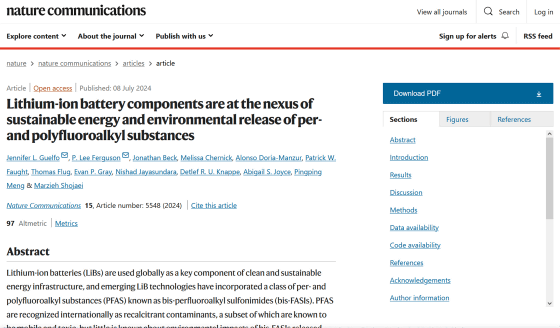It is pointed out that lithium-ion batteries used in EVs and smartphones are causing pollution due to 'eternal chemicals'

Lithium-ion batteries are used in a variety of gadgets, EVs, and renewable energy storage, and play an important role in promoting clean energy. However, a paper published in the scientific journal Nature Communications reported that lithium-ion batteries are a source of contamination by
Lithium-ion battery components are at the nexus of sustainable energy and environmental release of per- and polyfluoroalkyl substances | Nature Communications
https://www.nature.com/articles/s41467-024-49753-5

Lithium-Ion Batteries Are an Unidentified and Growing Source of PFAS Pollution | Duke Pratt School of Engineering
https://pratt.duke.edu/news/pfas-lithium-ion-batteries/
Lithium-ion batteries have a forever chemical problem - The Verge
https://www.theverge.com/24194493/forever-chemicals-pfas-lithium-ion-ev-rechargeable-batteries
PFAS is a general term for organic fluorine compounds in which multiple fluorine atoms are bonded to an alkyl chain , and has been used in various products for decades to increase their resistance to heat and chemicals. However, in recent years, it has been discovered that PFAS are difficult to decompose and remain in the environment for long periods of time, causing health hazards such as increased risk of cancer and low birth weight, and has become a social issue.
This time, a research team from Texas Tech University, Duke University, and other institutions studied a type of PFAS called bisperfluoroalkylsulfonimides (bis-FASIs). Bis-FASIs are used as electrolytes and binders in lithium-ion batteries, but their environmental impact is not well understood.
When the research team investigated samples from bis-FASIs manufacturing plants in the United States, Belgium, and France, it was found that the bis-FASIs concentration in soil, sediments, water, and snow reached 1 ppb (one part per billion). The US Environmental Protection Agency's regulations established in April 2024 set the upper limit for the concentration of the five major PFASs in drinking water at 1 to 4 ppt (one to four parts per trillion), and the value of 1 ppb is orders of magnitude higher than these limits.
In addition, the research team tested 17 types of lithium-ion batteries used in laptops, smartphones, tablets, EVs, etc., and detected bis-FASIs in 11 of them. Since it is estimated that only 5% of lithium-ion batteries are recycled, they also investigated leachate samples taken from several landfills in the southeastern United States. As a result, bis-FASIs concentrations close to 1 ppb were detected in the leachate, suggesting that bis-FASIs may be released into the environment from discarded lithium-ion batteries.

Although there are no federal regulations for bis-FASIs at the time of writing, toxicity tests have shown that concentrations of bis-FASIs similar to those found in the samples may alter the behavior and energy metabolism processes of aquatic organisms. However, existing methods using granular activated carbon and ion exchange to remove PFAS from drinking water have been shown to reduce the concentration of bis-FASIs in water.
'Our findings highlight the dilemmas surrounding the manufacturing, disposal, and recycling of clean energy infrastructure,' said Jennifer Guelfo , lead author of the study and an associate professor of environmental engineering at Texas Tech University. 'While it's important to reduce carbon emissions through technological innovations like EVs, they shouldn't come with the side effect of increasing PFAS contamination.'
Related Posts:







